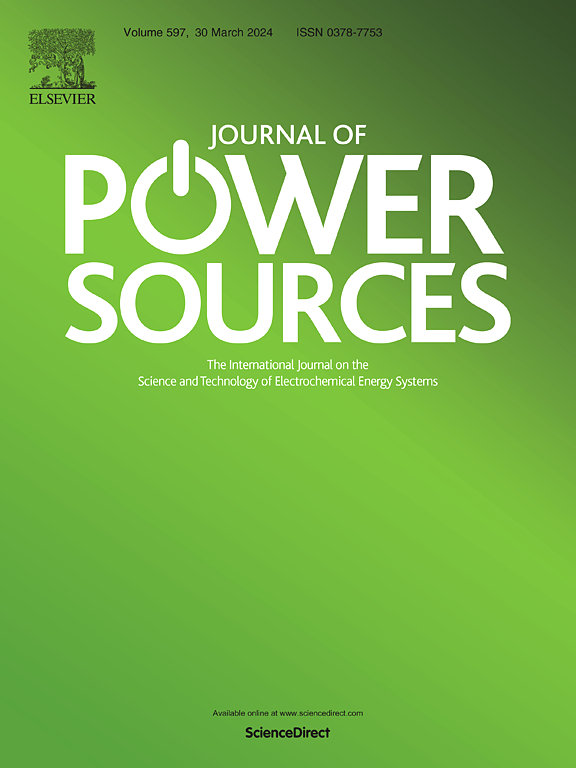Metal Co exsolution for catalyst design and electrochemical enhancement of non-stoichiometric solid oxide fuel cell cathodes
IF 8.1
2区 工程技术
Q1 CHEMISTRY, PHYSICAL
引用次数: 0
Abstract
In this study, the electrochemical properties of SmBa0.45Sr0.5(Co1-xFex)1.9O5+d (x = 0.3, 0.5, and 0.7) (SBSCF 1.9 oxide systems) and SmBa0.5Sr0.48(Co1-xFex)2.05O5+d (x = 0.3, 0.5, and 0.7) (SBSCF 2.05 oxide systems) are analyzed as a function of Fe substitution. Significantly, the phenomenon of Co exsolution in an oxidizing atmosphere is observed and its impact on electrochemical properties is analyzed in detail. The differences in the microstructure of exsolved Co particles, induced by the formation of oxygen vacancies resulting from compositional changes, are analyzed. Additionally, the mechanism underlying Co exsolution is elucidated.
SmBa0.45Sr0.5(Co0.7Fe0.3)1.9O5+d (SBSCF 1.9–0.3) forms a greater number of smaller exsolved Co particles compared to SmBa0.5Sr0.48(Co0.5Fe0.5)2.05O5+d (SBSCF 2.05–0.5), leading to an increased triple-phase boundary (TPB) density. As a result, SBSCF 1.9–0.3 exhibited relatively higher ORR activity and an ASR value of 0.21 Ω cm2 at 700 °C. In contrast, SBSCF 2.05–0.5 showed a higher ASR value of 0.64 Ω cm2 due to the presence of fewer exsolved Co particles. The metal Co exsolution observed in the oxidizing atmosphere in this study is thus demonstrated to be a critical factor in enhancing the electrochemical performance of solid oxide fuel cell (SOFC) cathodes.
金属Co溶解用于非化学计量固体氧化物燃料电池阴极的催化剂设计和电化学增强
本研究分析了SmBa0.45Sr0.5(Co1-xFex) 1.90 o5 +d (x = 0.3、0.5和0.7)(SBSCF 1.9氧化物体系)和SmBa0.5Sr0.48(Co1-xFex)2.05 o5 +d (x = 0.3、0.5和0.7)(SBSCF 2.05氧化物体系)的电化学性能。重要的是,观察到Co在氧化气氛中的溶出现象,并详细分析了其对电化学性能的影响。分析了Co组分变化引起的氧空位形成所导致的析出Co颗粒微观结构的差异。与SmBa0.5Sr0.48(Co0.5Fe0.5)2.05O5+d (SBSCF 2.05-0.5)相比,smba0.45 sr0.5 (Co0.7Fe0.3) 1.90 o5 +d (SBSCF 1.9-0.3)形成了更多的较小的析出Co颗粒,导致三相边界(TPB)密度增加。结果表明,SBSCF 1.9 ~ 0.3在700℃时表现出较高的ORR活性,ASR值为0.21 Ω cm2。相比之下,SBSCF 2.05-0.5的ASR值更高,为0.64 Ω cm2,这是由于溶解Co颗粒较少。因此,本研究中在氧化气氛中观察到的金属Co析出被证明是提高固体氧化物燃料电池(SOFC)阴极电化学性能的关键因素。
本文章由计算机程序翻译,如有差异,请以英文原文为准。
求助全文
约1分钟内获得全文
求助全文
来源期刊

Journal of Power Sources
工程技术-电化学
CiteScore
16.40
自引率
6.50%
发文量
1249
审稿时长
36 days
期刊介绍:
The Journal of Power Sources is a publication catering to researchers and technologists interested in various aspects of the science, technology, and applications of electrochemical power sources. It covers original research and reviews on primary and secondary batteries, fuel cells, supercapacitors, and photo-electrochemical cells.
Topics considered include the research, development and applications of nanomaterials and novel componentry for these devices. Examples of applications of these electrochemical power sources include:
• Portable electronics
• Electric and Hybrid Electric Vehicles
• Uninterruptible Power Supply (UPS) systems
• Storage of renewable energy
• Satellites and deep space probes
• Boats and ships, drones and aircrafts
• Wearable energy storage systems
 求助内容:
求助内容: 应助结果提醒方式:
应助结果提醒方式:


